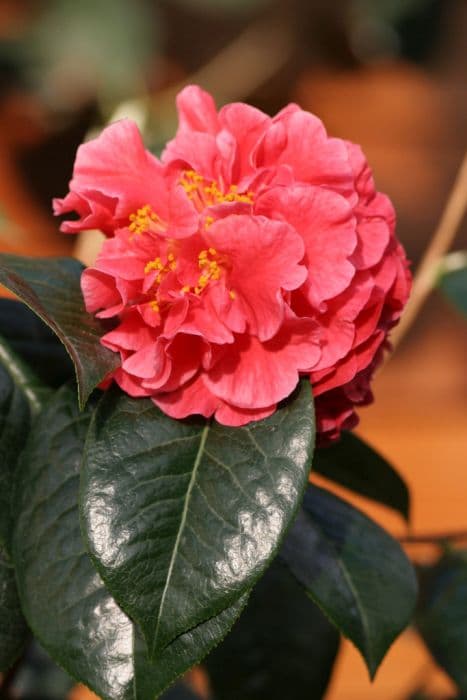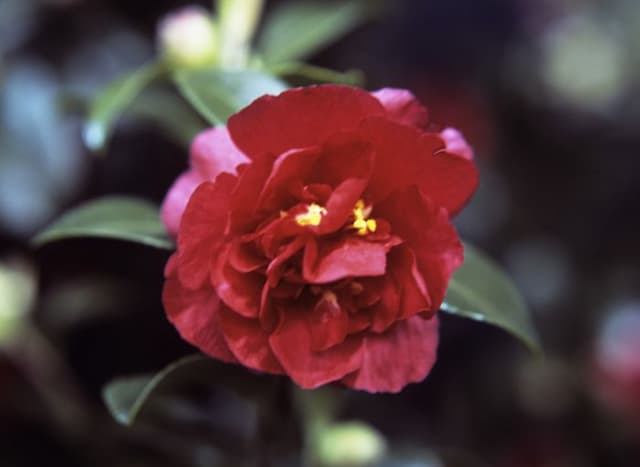Japanese Camellia Camellia japonica 'Australis'

ABOUT
The Camellia japonica 'Australis', commonly known as the Japanese camellia, is an evergreen shrub known for its attractive flowers and glossy foliage. Its leaves are dark green, leathery, and have a slightly serrated edge, providing a lush backdrop throughout the year. The plant is especially celebrated for its blooms, which appear predominantly in the cooler months, depending on the climate. The flowers of 'Australis' are large and showy with a rich, velvety texture. They come in a sumptuous shade of deep pink to red and are often characterized by a classic formal double form, meaning the petals are arranged in several concentric circles with no visible stamens. Each flower is quite substantial and can be quite striking against the dark foliage. The overall appearance of the Japanese camellia 'Australis' is one of elegance and sophistication, often making it a favored choice for ornamental planting in gardens that can accommodate their growing needs.
About this plant
 Names
NamesFamily
Theaceae
Synonyms
Japanese Camellia, Rose of Winter, Tsubaki
Common names
Camellia japonica 'Australis'.
 Toxicity
ToxicityTo humans
Camellia japonica, commonly known as Japanese camellia, is not considered toxic to humans. There are no common symptoms associated with poisoning because the plant is generally recognized as safe for human handling and incidental ingestion.
To pets
Japanese camellia is also not considered toxic to pets. Ingesting parts of the plant is unlikely to cause more than mild gastrointestinal upset, if any symptoms occur at all. There are no significant toxic consequences associated with pets consuming this plant.
 Characteristics
CharacteristicsLife cycle
Perennials
Foliage type
Evergreen
Color of leaves
Green
Flower color
Pink
Height
6-10 feet [1.8-3 meters]
Spread
6-10 feet [1.8-3 meters]
Plant type
Shrub
Hardiness zones
7-9
Native area
Japan
Benefits
 General Benefits
General Benefits- Aesthetic Appeal: The Camellia japonica 'Australis', often referred to as the Japanese Camellia, has large, beautiful flowers that enhance the visual appeal of gardens and landscapes.
- Seasonal Interest: It blooms in the late winter to early spring, providing color and interest during a time when few other plants are in flower.
- Privacy and Screening: With its dense growth habit, it can provide privacy screening for yards and gardens.
- Habitat for Wildlife: The flowers provide nectar for pollinators, while the dense foliage offers shelter for birds and other wildlife.
- Erosion Control: The root system can help stabilize the soil, reducing erosion on slopes and banks.
- Versatility in Landscaping: Can be used in a variety of garden designs, including formal, cottage, and woodland gardens.
- Low Maintenance: Once established, it requires minimal care, making it a good choice for gardeners seeking low-maintenance plants.
- Longevity: It's a hardy plant that can live for many years, possibly even centuries, with proper care.
- Symbolism: In many cultures, camellias represent love, affection, and admiration, bringing symbolic value to the landscape.
 Medical Properties
Medical Properties- This plant is not used for medical purposes.
 Air-purifying Qualities
Air-purifying QualitiesThis plant is not specifically known for air purifying qualities.
 Other Uses
Other Uses- Camellia japonica 'Australis', commonly known as Camellia, can be utilized for bonsai. Because of its beautiful blooms and lush foliage, it makes for an aesthetically pleasing bonsai plant.
- The petals of Camellia can be used in culinary dishes as an edible garnish—adding color and a unique touch to salads and desserts.
- The leaves of the Camellia plant can be processed to create Camellia tea oil, which is often used in cooking and seasoning ingredients in Asian cuisine.
- Camellia wood is hard and can be crafted into woodworking projects such as inlays, small pieces of furniture, or artisanal utensils and tools.
- The dense, glossy leaves of the Camellia can be used in floral arrangements to add contrast and structure to bouquets.
- Camellia flowers can be pressed and used in craft projects like bookmark making, framing, or in scrapbooking to add natural beauty and unique patterns.
- Used as a dye plant, the petals of Camellia have been historically used to make natural plant dyes for fabric and paper.
- Camellia petals can serve as a natural confetti alternative at weddings and celebrations, being both biodegradable and decorative.
- Ancient samurai in Japan polished their swords and equipment with Camellia oil to prevent rust and corrosion.
- Camellia leaves can be used as a mulch or compost material, enriching the soil as they break down and providing benefits for garden plants.
Interesting Facts
 Feng Shui
Feng ShuiCamellia is often associated with positive energy or chi when used in Feng Shui. To utilize Camellia in Feng Shui, one might place it in areas of the home that need a boost of energy or where a sense of beauty and refinement is desired, such as in living spaces or near the front entrance. In Feng Shui, the lush flowers of the Camellia can represent wealth and abundance, and its evergreen leaves symbolize persistence and fortitude. Choosing a healthy Camellia plant and placing it in well-lit areas of the home can help promote these positive attributes.
 Zodiac Sign Compitability
Zodiac Sign CompitabilityThe Camellia is not used in astrology practice.
 Plant Symbolism
Plant Symbolism- Admiration: Camellias often symbolize deep respect and admiration due to their perfection and beauty.
- Perfection: With its flawless, symmetrical blooms, the Camellia signifies the ideal, perfection, and the divine.
- Love and Affection: Camellias generally are associated with expressing feelings of love, affection, and devotion.
- Longevity: The Camellia's ability to live for many years symbolizes long-lasting life and endurance.
- Faithfulness: In particular cultures, the giving of a Camellia can mean the sender is faithful or the recipient is desired to remain faithful.
 Water
WaterCamellias, specifically the Japanese Camellia, require consistent moisture, so water them with about 1 inch of water weekly. Adjust frequency to account for rainfall, ensuring that the soil remains moist but not soggy. During dry spells, you might need to water twice a week. Be cautious not to overwater, as camellias are sensitive to root rot. A methodical approach is to slowly pour water around the base of the plant until the desired amount is reached, allowing it to soak into the soil without running off.
 Light
LightJapanese Camellias thrive in light that is bright but filtered. Direct morning sun with afternoon shade—or dappled light throughout the day—is ideal. Avoid exposing them to the harsh afternoon sun. Positioning the plant in a spot that replicates the light conditions of a forest understory is perfect for its growth.
 Temperature
TemperatureJapanese Camellias prefer moderate temperatures and do best in a range of 60 to 80 degrees Fahrenheit. Ensure the location protects them from extreme cold, as they can tolerate minimum temperatures down to about 20 degrees Fahrenheit. The ideal growing condition is a temperate, stable climate without abrupt temperature swings.
 Pruning
PruningPrune Japanese Camellias to maintain shape and remove dead or weak growth. Do this after they finish blooming in spring to avoid cutting off next year's buds. Annually thinning out crowded branches also improves air circulation, reducing the risk of disease. Pruning is best done sparingly since the plant has a slow growth rate.
 Cleaning
CleaningAs needed
 Soil
SoilCamellia (Camellia japonica 'Australis') prefers well-draining, acidic soil with a pH between 5.0 and 6.5. A suitable soil mix can include equal parts peat moss, pine bark, and coarse sand or perlite. Regularly amending the soil with organic matter will help maintain its structure and acidity, promoting healthy growth.
 Repotting
RepottingCamellias, including the 'Australis' variety, should be repotted every 2-3 years to refresh the soil and accommodate root growth. However, they prefer to be slightly root-bound, so ensure the new pot is only slightly larger than the current one.
 Humidity & Misting
Humidity & MistingCamellia 'Australis' thrives in moderate to high humidity levels, ideally around 50-60%. This plant benefits from a humid environment, but ensure good air circulation to prevent fungal diseases.
 Suitable locations
Suitable locationsIndoor
Place in bright, indirect light, keep soil moist.
Outdoor
Plant in partial shade, shelter from strong winds.
Hardiness zone
7-9 USDA
 Life cycle
Life cycleThe life cycle of Camellia japonica 'Australis' begins with seed germination, where the seeds require a period of cold stratification before they will sprout. Once germinated, the seedling stage involves the development of a root system and juvenile leaves. As the plant enters the vegetative stage, it grows to maturity, forming a woody structure and evergreen foliage. The reproductive stage is marked by the production of large, showy flowers typically in late winter or early spring, which can result in pollination and seed set if compatible partners are available. After pollination, seeds develop within the fruits, which are technically dry capsules. The mature Camellia plant continues to live for many years, capable of flowering annually and producing seeds for new generations, with proper care extending their longevity.
 Propogation
PropogationPropogation time
Early Spring
Camellia japonica 'Australis', commonly known as the Japanese camellia, is most commonly propagated by semi-hardwood cuttings. This method typically takes place during the late summer when the new growth has begun to mature and harden slightly. Cuttings should be about 4 to 6 inches long, with leaves removed from the lower half. The cut end of the cutting is often dipped in a rooting hormone to enhance root development and then placed in a potting mix that provides good drainage. The pot should be kept in a warm area with indirect light and the soil should be kept consistently moist but not soggy. Roots usually develop within a few months, after which they can be transplanted into individual pots or directly into the garden.









